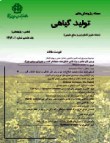Effect of compost levels on micro elements uptake and relationship with physiological traits of saffron (Crocus sativus L.)
Author(s):
Article Type:
Research/Original Article (دارای رتبه معتبر)
Abstract:
Background and objectives
The most expensive medicinal spicy plant in the Middle East countries is saffron (Crocus sativus L.). Saffron is prepared from dried, bright red stigma .and its value is determined by the color compounds, carotenoids, crocin, and other crocetinglocosyl ester, slightly bitter flavor, picrocrocin, and pleasant aroma, safranal. Nutrition management is one of the main agronomic factor affecting chemical properties and yield of saffron. Municipal waste compost is one natural fertilizer which moreover contain micro elements and compost to be increased ability this elements. Therefore the effects of application of municipal waste compost on uptake micro elements (Fe, Cu, Zn and Mg) in saffron plant and relation with arable characteristics and yield of saffron were evaluated under field conditions.
Materials and methods
This experiment was carried out based on a randomized completely block design with three replications in research farm of University of Birjand, Iran, during cropping year 2015-2016. Treatments were four levels municipal waste compost (0, 5, 10 and 20 t.ha-1). The measured indices were included of concentration of micro elements (soil, leaf, corm and stigma), pigments photosynthesis (chl a, b and total and carotenoids) and arable characteristics (leaf fresh and dry weight, flower fresh yield and dry yield of stigma). Finally, data analysis was done using SAS 9.1 and means were compared by Duncan’s multiple range test at 5% level of probability.
Results
Results showed that municipal waste compost rate improved the concentration of Cu, Fe and Mn of soil, corm and stigma of saffron beside control. The highest concentration Fe (3.038 and 4.334 mg. kg-1), Mn (1.980 and 3.116 mg.kg-1) and Cu (1.094 and 1.802 mg.kg-1) of flower and corm were obtained in plants treated with 20 t.ha-1 municipal waste compost while the lowest values were recorded in the control. Also results showed that municipal waste compost improved the concentration Zn of soil and leaf beside control. The highest concentration Zn (1.633 and 1.240 mg.kg-1) of soil and leaf were obtained in plants treated with 20 and 10 t.ha-1 municipal waste compost. Leaf carotenoids and total chlorophyll, flower and stigma yield were influenced by municipal waste compost treatments. The highest flower and stigma yield were obtained in plants treated with 10 t.ha-1 municipal waste compost.
Conclusion
Thus, results showed that municipal waste compost has significant impact on uptake micro elements of saffron soil and plant. Municipal waste compost hereby improved the arable and yield characteristics of saffron under field conditions.Keywords:
Language:
Persian
Published:
Journal of Plant Production, Volume:26 Issue: 1, 2019
Pages:
61 to 74
magiran.com/p1993561
دانلود و مطالعه متن این مقاله با یکی از روشهای زیر امکان پذیر است:
اشتراک شخصی
با عضویت و پرداخت آنلاین حق اشتراک یکساله به مبلغ 1,390,000ريال میتوانید 70 عنوان مطلب دانلود کنید!
اشتراک سازمانی
به کتابخانه دانشگاه یا محل کار خود پیشنهاد کنید تا اشتراک سازمانی این پایگاه را برای دسترسی نامحدود همه کاربران به متن مطالب تهیه نمایند!
توجه!
- حق عضویت دریافتی صرف حمایت از نشریات عضو و نگهداری، تکمیل و توسعه مگیران میشود.
- پرداخت حق اشتراک و دانلود مقالات اجازه بازنشر آن در سایر رسانههای چاپی و دیجیتال را به کاربر نمیدهد.
دسترسی سراسری کاربران دانشگاه پیام نور!
اعضای هیئت علمی و دانشجویان دانشگاه پیام نور در سراسر کشور، در صورت ثبت نام با ایمیل دانشگاهی، تا پایان فروردین ماه 1403 به مقالات سایت دسترسی خواهند داشت!
In order to view content subscription is required
Personal subscription
Subscribe magiran.com for 70 € euros via PayPal and download 70 articles during a year.
Organization subscription
Please contact us to subscribe your university or library for unlimited access!


